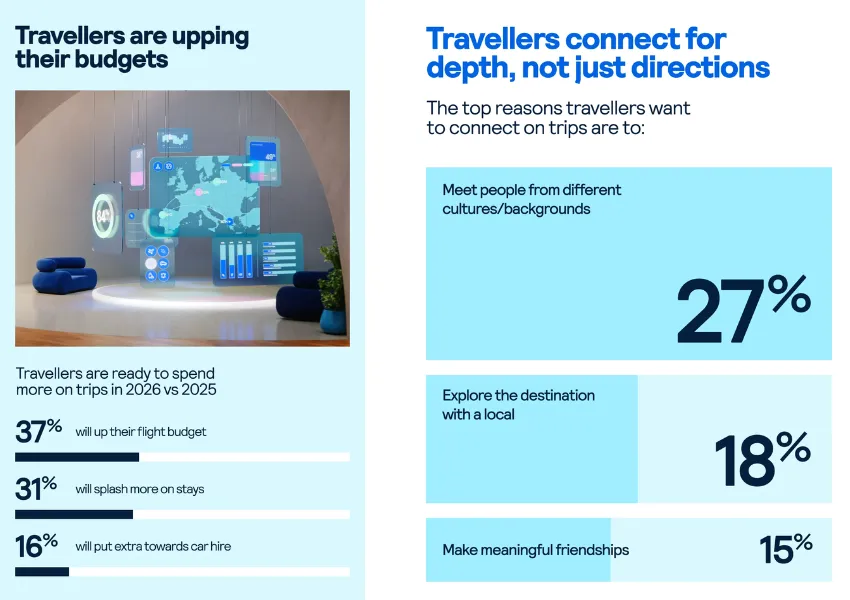A new era of hyper-personalised travel is on the horizon for Indian tourists, according to Skyscanner’s ‘Travel Trends 2026 Report’. The study, unveiled in New Delhi, identifies a decisive move away from generic holidays towards trips meticulously crafted around personal passions, identities, and interests.
The data reveals robust travel demand, with 59 per cent of Indian travellers planning to take more trips in 2026 compared to the previous year. This intent is backed by spending power, as 58 per cent are willing to allocate the same or more on flights, alongside 49 per cent on accommodation and 35 per cent on car hire.
Celebrated on the cricket field as ‘Mr. 360’ for his all-round play, Suryakumar ‘SKY’ Yadav shared his take on the importance of smart travel planning, establishing himself as the Mr. 360 of travel as well. "Travel has always been close to my heart — it’s my way of switching off, exploring new cultures, and finding hidden gems along the way. Just like cricket, it keeps me curious and excited. With Skyscanner, I hope more people see how easy it can be to plan trips that are fun, affordable, and full of memories waiting to be made.”
The rise of the passion-led itinerary

The report crystallises this shift into seven key trends for 2026, illustrating how hobbies and daily rituals are now central to travel planning. Dubbed ‘Glowmads’, beauty and wellness are significantly influencing destinations, with 57 per cent of Indians stocking up on skincare abroad and nearly half choosing locations for their wellness appeal.
Another trend, ‘Shelf Discovery’, sees grocery shopping transformed into a cultural activity. Nearly 80 per cent of Indian travellers frequently visit local supermarkets abroad, viewing the aisles as a portal to authentic local flavours. Furthermore, ‘Book-bound’ travellers are turning literature into itineraries, with nearly 8 in 10 Indians having booked or considering a book-inspired getaway.
Other trends include ‘Altitude Shift’, where 92 per cent dream of mountain escapes, and ‘Destination Check-In’, where 82 per cent select a location specifically for a compelling hotel stay. The spirit of ‘Family Miles’ remains strong, with 47 per cent having travelled with their parents as adults, and ‘Catching Flights & Feelings’ highlights that 87 per cent have forged new connections during their journeys.
Technology and AI
.jpg)
Underpinning this personalised approach is a strong reliance on digital tools, particularly Artificial Intelligence (AI). A staggering 86 per cent of Indian travellers expressed confidence in using AI to plan and book their trips in 2026, positioning India as a global leader in the adoption of AI for travel.
Neel Ghose, Skyscanner Travel Trends and Destinations Expert, commented, “One in three travellers is steering clear of touristy spots in favour of quieter, authentic alternatives. In planning their journeys, travellers are increasingly turning to digital tools, while social media motivates them to seek experiences that genuinely reflect their individual tastes.”
He added, “As travel in India continues to grow rapidly, technology remains at the heart of this evolution. With 86 per cent expressing confidence in using AI to plan and book their trips in 2026, our report shows that Indians lead the world in embracing AI for travel. At Skyscanner, tools like the app-exclusive Savvy Search, powered by OpenAI’s ChatGPT, help bring this to life by offering curated destination ideas complete with flight options. This rise in personalisation underpins our 2026 theme: travel is no longer just about escaping life – it’s about discovering deeper ways to connect with it.”
Strategic spending and destination choices

Despite the increased appetite for travel, Indian tourists remain highly cost-conscious. The primary factors shaping their itineraries are food (63 per cent), flight costs (60 per cent), accommodation costs (56 per cent), and visa requirements (48 per cent). This indicates a traveller who is dedicated to enriching experiences without compromising on smart spending.
This strategic approach is reflected in the top destination choices for 2026. The list of trending locations is led by Jorhat, India, which saw a 493 per cent surge in searches, and Jaffna, Sri Lanka, with a 325 per cent increase, signalling a strong desire to explore culturally rich, lesser-known gems.
Conversely, the list of best-value destinations reveals where Indians are finding smarter deals. Tirupati, India, leads with an 18 per cent drop in flight prices, followed by Langkawi, Malaysia (17 per cent drop), and Berlin, Germany (16 per cent drop). Improved air connectivity and new routes are making these destinations more accessible.
“The surge in searches for places like Jorhat and Jaffna reflects a desire to explore relatively lesser-known gems, rich in heritage and local flavour. On the other hand, the best value destinations have benefited from improved connectivity, new routes, and expanded flight options, making traditionally premium locations like Berlin more accessible to a larger number of Indians. Together, this shows how travellers are becoming more intentional and strategic in their choices for 2026," explained Ghose.
The comprehensive report from Skyscanner confirms that for the modern Indian tourist, travel is no longer an escape from life, but a deeper, more personalised way to connect with it. |